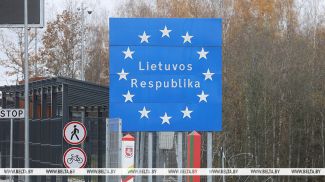MINSK, 23 November (BelTA) – At least two types of flashbangs were used against civilians at the Belarusian-Polish border on 16 November, BelTA learned from Chairman of the State Forensic Examination Committee of Belarus Aleksei Volkov.
The official said: “Just yesterday we finished a forensic study of fragments of the flashbangs we'd received for examination. We can confidently state that at least two types of flashbangs were used.”
Aleksei Volkov explained that one type produces a flash of light and noise while the other type was also filled with tear gas.

Specialists found traces of a CS-type irritant agent (a synthetic substance) and traces of elemental sulfur on the surfaces of two shells of P-2M type grenades, one trigger mechanism, and the shell of a chemical pyrotechnical part.
Apart from that, Belarusian forensic experts found layers of the deltametrin insecticide, which is a toxic substance.
BelTA reported previously that after examining the samples collected at the site of the incident (a section of the Belarusian-Polish border near the border checkpoint Bruzgi in Belarus' territory) on 16 November Belarusian forensic experts identified an extract of capsicum alkaloids. According to Aleksei Volkov, it is a potent substance that can cause tears, eye spasms, and so on.

The official said: “Judging by the bodily injuries we now record in the course of forensic evaluations, we can definitely say they have been caused by these potent chemicals.” He added that potent chemicals, including pesticides, had been used in the form of aerosols. The water cannons the Polish law enforcement personnel used against the migrants were also filled with these liquids.
As of the morning on 23 November over 120 medicolegal examinations were performed, including over 20 examinations of the underage, including ten minors.
“The bodily injuries the examinations reveal vary. But all of them include injuries to the upper respiratory tract, eyes, mucous membranes, skin areas as well as burns in some places,” Aleksei Volkov said.

Apart from that, complex forensic studies of the objects collected at the incident site on 16 November and during follow-up examinations continue. “There are rather many objects and we continue getting more of them. We can talk about results as we complete the studies,” the chairman of the State Forensic Examination Committee of Belarus said.
Work continues. A group of forensic experts from the Grodno Oblast branch and from the headquarters of the State Forensic Examination Committee is working at the site.
Aleksei Volkov said: “I'd like to point out that the use of such potent substances that we've found in the course of forensic studies was definitely dangerous for the lives and health of all the people in the impact zone, in the area where these substances were dispersed.”













